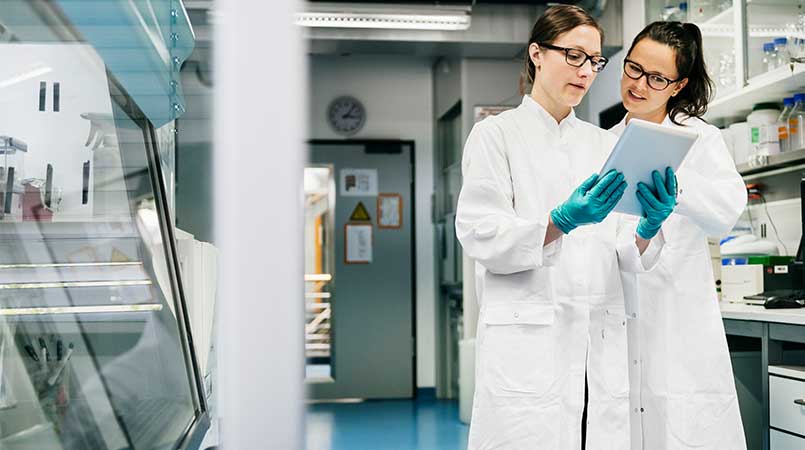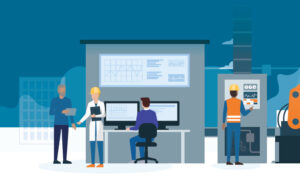IH 101 Part 4: Lab Analysis – Uncovering Hidden Gems of Efficiency
04/12/2021 | Dave Risi, Dave Risi, CIH, CSP

In Part 3 of our IH 101 blog series “Sampling Plans – Moving Beyond Compliance” we learned how to use data obtained during our qualitative exposure assessment (QEA) to help define sampling priorities when establishing your sampling plan. In Part 4, we’ll focus on best practices when working with your IH analytical laboratory to increase your efficiency when conducting your sampling in the field.
Recommended Readings
Before you read on, we recommend reviewing the previous installments of our IH 101 Introduction to Industrial Hygiene Program Management series:
- Part 1 – Similar Exposure Groups (SEGs)
- Part 2 – Qualitative Exposure Assessments (QEAs)
- Part 3 – Sampling Plans
We also highly recommend downloading our IH Program Cycle Infographic and IH Program Guide on the 7 steps to effective industrial hygiene (IH) program management to help understand how each of these parts fit into the overall IH program management structure.
Now…Let’s Talk About Labs
Before jumping into our discussion on how to increase efficiency when working with your IH lab, it’s important to make sure you are working with right one.
Which Laboratory Should I Use?
IH labs come in all shapes and sizes. Some are large and provide a lot of additional services, while some are smaller local labs that specialize in certain analytical methods. To help determine the best fit for you and your company, consider the following key factors:
Analysis performed: Reach out to prospective IH labs with a list of the physical and chemical stressors you may be asking them to analyze samples for to ensure they offer the analytical capabilities needed to process those samples. Make sure you ask if they outsource the analysis, and if so, make sure you are comfortable with that. There’s no sense selecting a lab that only does a small fraction of the analysis methods you need.
One or multiple labs?: Based on analytical requirements, you may ultimately need to use multiple labs. Using the methodology prescribed below, you will ensure you address the highest priorities with respect to your annual budget for monitoring.
Price: Sampling effort should be focused on the items that need additional data and investigation. For example, those annual noise surveys you conduct every year that show noise levels are consistently above 95 dBA can be removed or greatly reduced. Remember, the overall number of samples you collect should be minimized over time; saving you money and giving you back time to focus on more important projects.
On-staff CIH: Several of the larger labs offer free or low-cost consultation with their on-staff CIHs. This comes in handy if you need additional support determining the best sampling methods or just want an IH expert to review your work.
Equipment Loan & Rental: Several labs offer air sampling pumps for free and will often rent noise dosimeters and other direct reading equipment. This provides a great cost-saving option if you’re not taking enough samples to justify purchasing your own equipment. Air sampling pumps should come with their own recently calibrated rotometer for field calibrations. Other direct reading equipment should come with their field calibration gases or noise source for dosimeters.
Location: For most, lab location is not an issue. Sample media can easily be shipped next day air to-and-from most places. However, location becomes important if you need to swing by their office to pick up media on short notice, or when analyzing a highly volatile agent and you don’t want to deal with packing it in dry ice or some cooled packaging.
Accreditation: Most IH laboratories are AIHA LAP accredited. We recommend this level of accreditation for analysis of most stressors. Additional accreditations are available for specific stressors including lead (ELLAP), mold and other microbiological samples (EMLAP). If you are a global corporation, you should consider looking for laboratories that are also ISO/IEC 17025 accredited.
Depending on the state(s) you operate in, you may also need to consider state accreditations. Some states that have their own accreditations include Louisiana, New York, New Jersey and Texas.
Streamline Your Process
One of the most intensive administrative tasks when working with IH labs is creating your chain of custody (COC) form. It can be a time-consuming task – one that most of us don’t look forward to at the end of a long day of sampling. However, several IH laboratories are now offering online services to complete your COCs online, and SGS Galson even has a convenient web portal to help you easily complete and submit your COCs.
Several labs also offer direct access to their sampling and analysis guides (SAGs). Your lab’s SAG provides access to their analytical services catalog including information such as analysis methods, limits of detection, flow rates and required sample volumes. Having this information readily available helps ensure your planned sampling is performed according to proper procedures, and helps minimize questions or the need to resample.
Lorem ipsum dolor sit amet, consectetur adipiscing elit.
Challenges with Lab Interfaces
Most IH software programs include interfaces that provide the ability to send COCs to labs and upload analytical results. However, the challenge with many of these lab interfaces is implementing them properly and keeping them working as analytical parameters and requirements change. It can be an administrative nightmare requiring months to set up and additional support every time there is a change with the lab SAGs, or any time you add a new stressor to your database.
Due to the level of effort required to maintain these interfaces, these capabilities have traditionally been limited to the larger labs and corporations. The average facility simply doesn’t have the IT resources or personnel required to keep these interfaces functional and up-to-date. The result is that only a small minority of companies and laboratories have a functioning interface to help streamline their COC submittals and upload of analytical results…until now.
A New Opportunity to Optimize Your Lab Interface
VelocityEHS has built an IH solution that eliminates all of the COC and lab interface barriers, and makes flexible lab interface capabilities available to companies and labs of any size. The core feature that makes this all possible is our Global Chemical & OEL Database.
Laboratories can easily map their laboratory information management system (LIMS) to our master list of stressors. Once mapped, we can provide direct access to any number of companies in a matter of minutes, with no additional effort required by the labs. By simplifying this process, smaller labs are now able to offer the interface services that used to be limited to only the larger, more sophisticated labs.
VelocityEHS also gives users the ability to directly order analytical services via in-app access to each lab’s catalog when building your surveys. Once the services are identified, we provide the lab’s SAG information directly to users to ensure they know key sampling parameters like detection limits, flow rates, minimum sample collection volumes and times, etc.
The result of having all this information at your fingertips is more accurate sampling and a more accurate COC that can be quickly generated at the end of a long day of sampling. Since you are essentially ordering directly from the lab’s catalog, the COC will be accurate. This all but eliminates questions and confusion between you and your laboratory, saving you time and money from any sampling errors or having the wrong analytical services performed.
Other IH Program Resources
Working with your analytical lab is just one of the many moving parts that make up an effective IH program. Your SEGs, QEAs, sampling plans, data analytics, reporting systems, medical surveillance and program evaluation processes all deserve equal focus, and should be carefully coordinated to ensure optimum IH program performance.
Our certified IH experts have developed two new complimentary resources – the IH Program Cycle Infographic and IH Program Guide which will introduce you to a proven, process-based IH program management framework built around continuous improvement principles and AIHA best-practices. Download them today!
Until Next Time…
VelocityEHS IH Solutions give you a software system that’s purpose-built to coordinate and maintain a comprehensive IH program founded on AIHA best practices. Designed by our in-house team of Certified Industrial Hygienists (CIHs), VelocityEHS IH Solutions help you easily assess and control workplace stressors, automate time-consuming IH program tasks, and maintain a world-class IH program no matter your level of IH expertise. Visit our IH Solutions Page to Learn More!
Ready to see for yourself how VelocityEHS can help you revolutionize your IH program? Contact Us or Request a Demo today!









